Business Models and Growing Organisations: Report Analysis
VerifiedAdded on 2020/06/06
|19
|6159
|324
Report
AI Summary
This report provides a comprehensive analysis of business models and growth strategies, focusing on market penetration, market expansion, product expansion, diversification, and acquisition strategies. The report uses Unicorn Grocery Ltd. as a case study, examining the differences between strategy and planning, and the impact of various growth approaches. It delves into revenue sources for different business models, methods for measuring business performance, and examples of innovation. Furthermore, the report evaluates environmental scanning as a tool for identifying business opportunities and explores strategic fit in determining growth options. The analysis includes the impact of growth strategies on financial and human resources. The report concludes with a discussion of the challenges and opportunities associated with business expansion, providing insights for students studying business development.
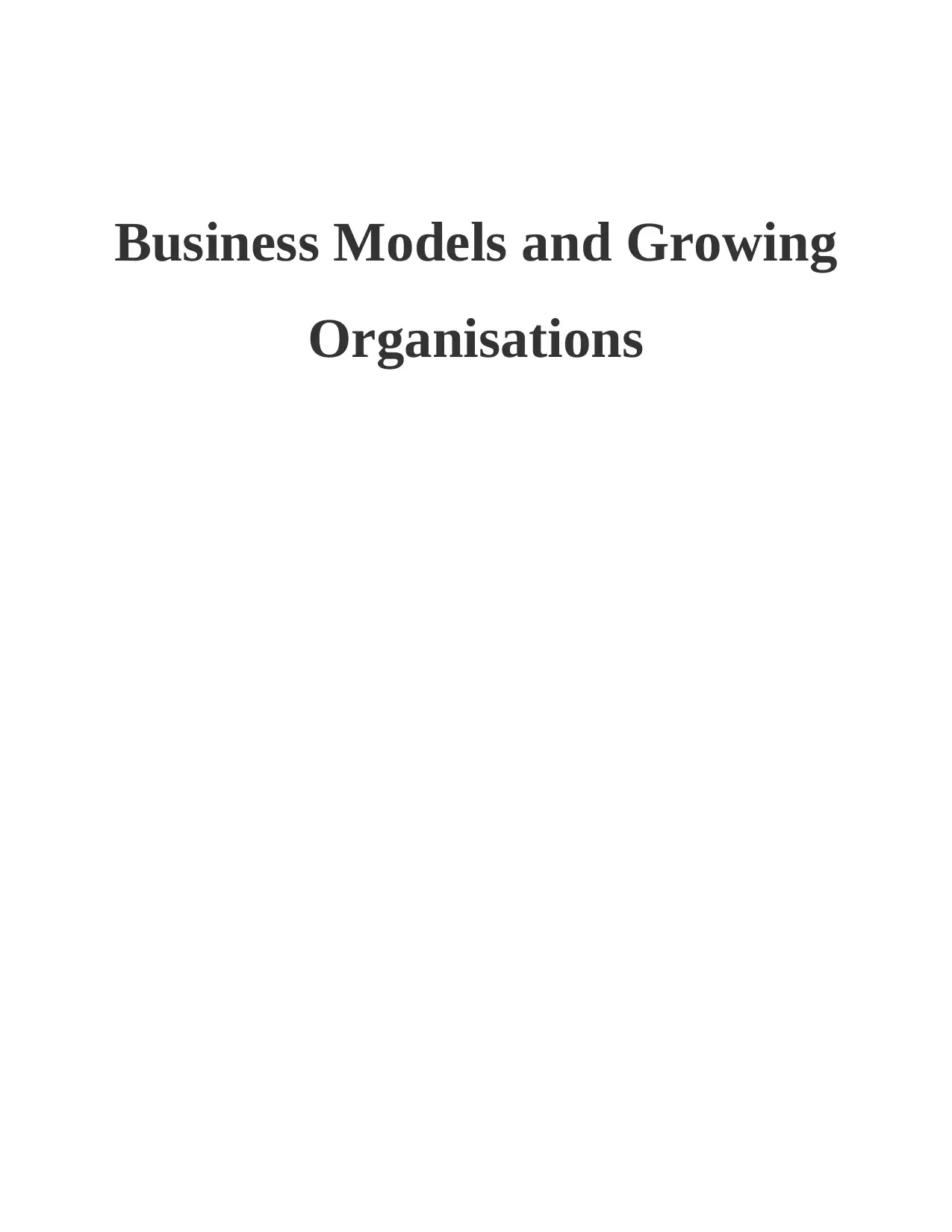
Business Models and Growing
Organisations
Organisations
Paraphrase This Document
Need a fresh take? Get an instant paraphrase of this document with our AI Paraphraser
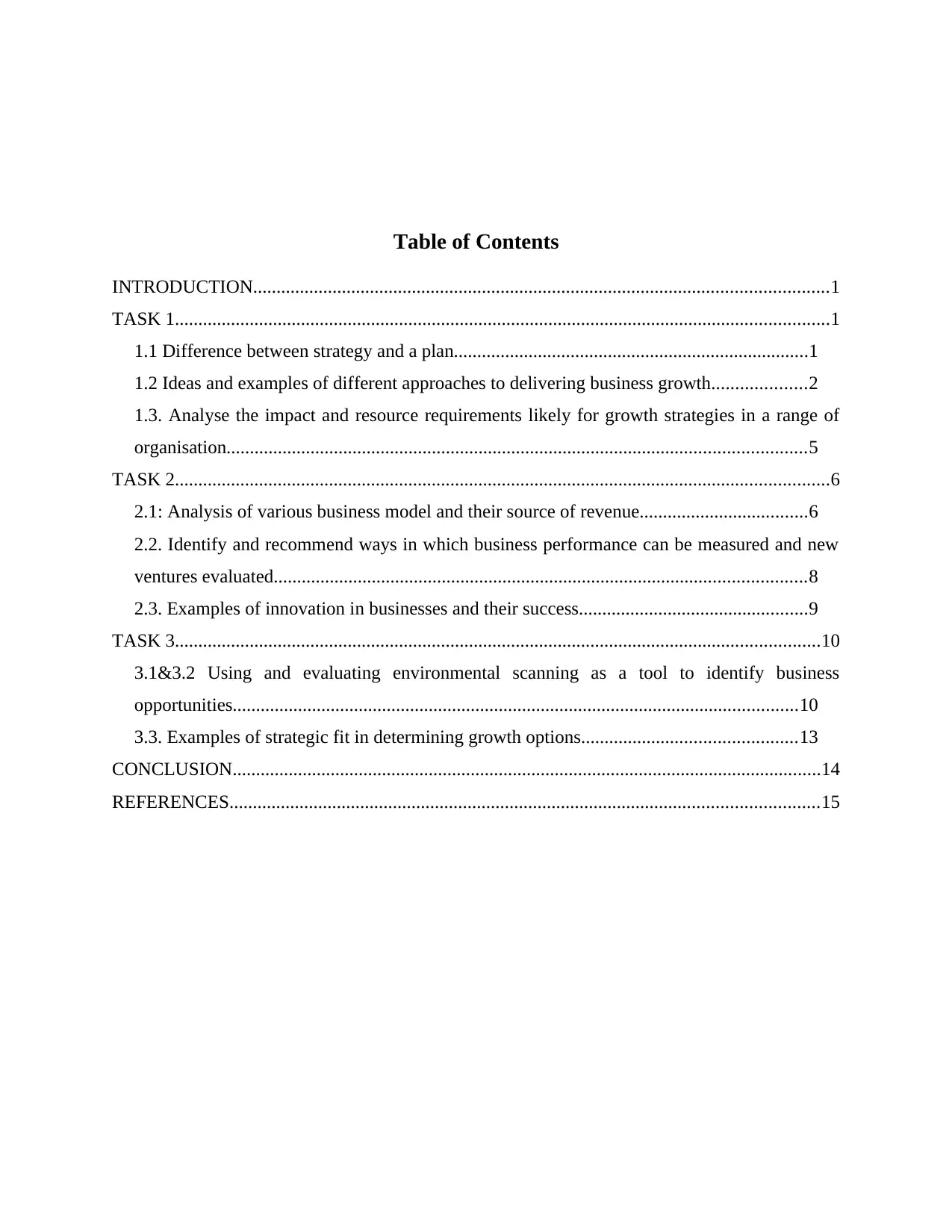
Table of Contents
INTRODUCTION...........................................................................................................................1
TASK 1............................................................................................................................................1
1.1 Difference between strategy and a plan............................................................................1
1.2 Ideas and examples of different approaches to delivering business growth....................2
1.3. Analyse the impact and resource requirements likely for growth strategies in a range of
organisation............................................................................................................................5
TASK 2............................................................................................................................................6
2.1: Analysis of various business model and their source of revenue....................................6
2.2. Identify and recommend ways in which business performance can be measured and new
ventures evaluated..................................................................................................................8
2.3. Examples of innovation in businesses and their success.................................................9
TASK 3..........................................................................................................................................10
3.1&3.2 Using and evaluating environmental scanning as a tool to identify business
opportunities.........................................................................................................................10
3.3. Examples of strategic fit in determining growth options..............................................13
CONCLUSION..............................................................................................................................14
REFERENCES..............................................................................................................................15
INTRODUCTION...........................................................................................................................1
TASK 1............................................................................................................................................1
1.1 Difference between strategy and a plan............................................................................1
1.2 Ideas and examples of different approaches to delivering business growth....................2
1.3. Analyse the impact and resource requirements likely for growth strategies in a range of
organisation............................................................................................................................5
TASK 2............................................................................................................................................6
2.1: Analysis of various business model and their source of revenue....................................6
2.2. Identify and recommend ways in which business performance can be measured and new
ventures evaluated..................................................................................................................8
2.3. Examples of innovation in businesses and their success.................................................9
TASK 3..........................................................................................................................................10
3.1&3.2 Using and evaluating environmental scanning as a tool to identify business
opportunities.........................................................................................................................10
3.3. Examples of strategic fit in determining growth options..............................................13
CONCLUSION..............................................................................................................................14
REFERENCES..............................................................................................................................15
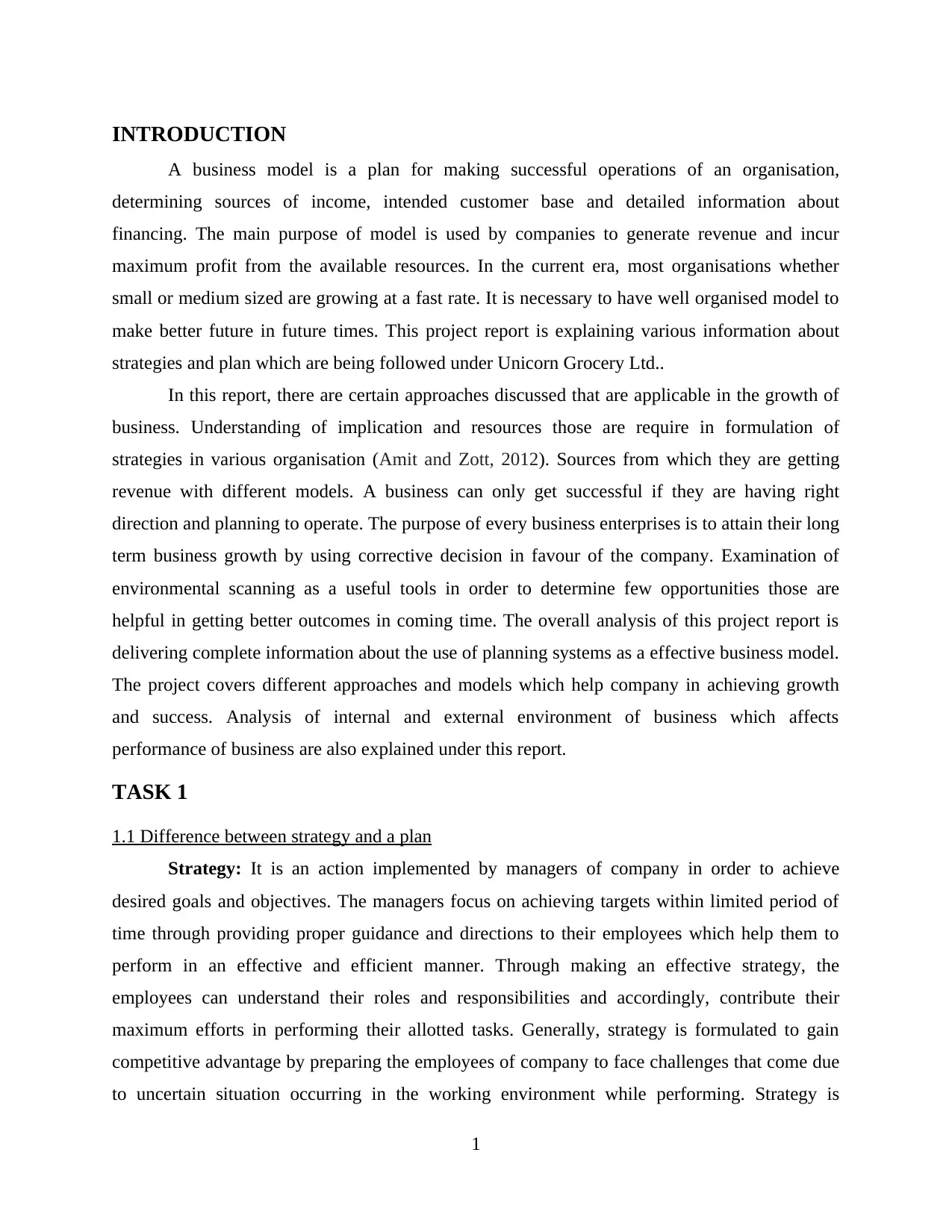
INTRODUCTION
A business model is a plan for making successful operations of an organisation,
determining sources of income, intended customer base and detailed information about
financing. The main purpose of model is used by companies to generate revenue and incur
maximum profit from the available resources. In the current era, most organisations whether
small or medium sized are growing at a fast rate. It is necessary to have well organised model to
make better future in future times. This project report is explaining various information about
strategies and plan which are being followed under Unicorn Grocery Ltd..
In this report, there are certain approaches discussed that are applicable in the growth of
business. Understanding of implication and resources those are require in formulation of
strategies in various organisation (Amit and Zott, 2012). Sources from which they are getting
revenue with different models. A business can only get successful if they are having right
direction and planning to operate. The purpose of every business enterprises is to attain their long
term business growth by using corrective decision in favour of the company. Examination of
environmental scanning as a useful tools in order to determine few opportunities those are
helpful in getting better outcomes in coming time. The overall analysis of this project report is
delivering complete information about the use of planning systems as a effective business model.
The project covers different approaches and models which help company in achieving growth
and success. Analysis of internal and external environment of business which affects
performance of business are also explained under this report.
TASK 1
1.1 Difference between strategy and a plan
Strategy: It is an action implemented by managers of company in order to achieve
desired goals and objectives. The managers focus on achieving targets within limited period of
time through providing proper guidance and directions to their employees which help them to
perform in an effective and efficient manner. Through making an effective strategy, the
employees can understand their roles and responsibilities and accordingly, contribute their
maximum efforts in performing their allotted tasks. Generally, strategy is formulated to gain
competitive advantage by preparing the employees of company to face challenges that come due
to uncertain situation occurring in the working environment while performing. Strategy is
1
A business model is a plan for making successful operations of an organisation,
determining sources of income, intended customer base and detailed information about
financing. The main purpose of model is used by companies to generate revenue and incur
maximum profit from the available resources. In the current era, most organisations whether
small or medium sized are growing at a fast rate. It is necessary to have well organised model to
make better future in future times. This project report is explaining various information about
strategies and plan which are being followed under Unicorn Grocery Ltd..
In this report, there are certain approaches discussed that are applicable in the growth of
business. Understanding of implication and resources those are require in formulation of
strategies in various organisation (Amit and Zott, 2012). Sources from which they are getting
revenue with different models. A business can only get successful if they are having right
direction and planning to operate. The purpose of every business enterprises is to attain their long
term business growth by using corrective decision in favour of the company. Examination of
environmental scanning as a useful tools in order to determine few opportunities those are
helpful in getting better outcomes in coming time. The overall analysis of this project report is
delivering complete information about the use of planning systems as a effective business model.
The project covers different approaches and models which help company in achieving growth
and success. Analysis of internal and external environment of business which affects
performance of business are also explained under this report.
TASK 1
1.1 Difference between strategy and a plan
Strategy: It is an action implemented by managers of company in order to achieve
desired goals and objectives. The managers focus on achieving targets within limited period of
time through providing proper guidance and directions to their employees which help them to
perform in an effective and efficient manner. Through making an effective strategy, the
employees can understand their roles and responsibilities and accordingly, contribute their
maximum efforts in performing their allotted tasks. Generally, strategy is formulated to gain
competitive advantage by preparing the employees of company to face challenges that come due
to uncertain situation occurring in the working environment while performing. Strategy is
1
⊘ This is a preview!⊘
Do you want full access?
Subscribe today to unlock all pages.

Trusted by 1+ million students worldwide
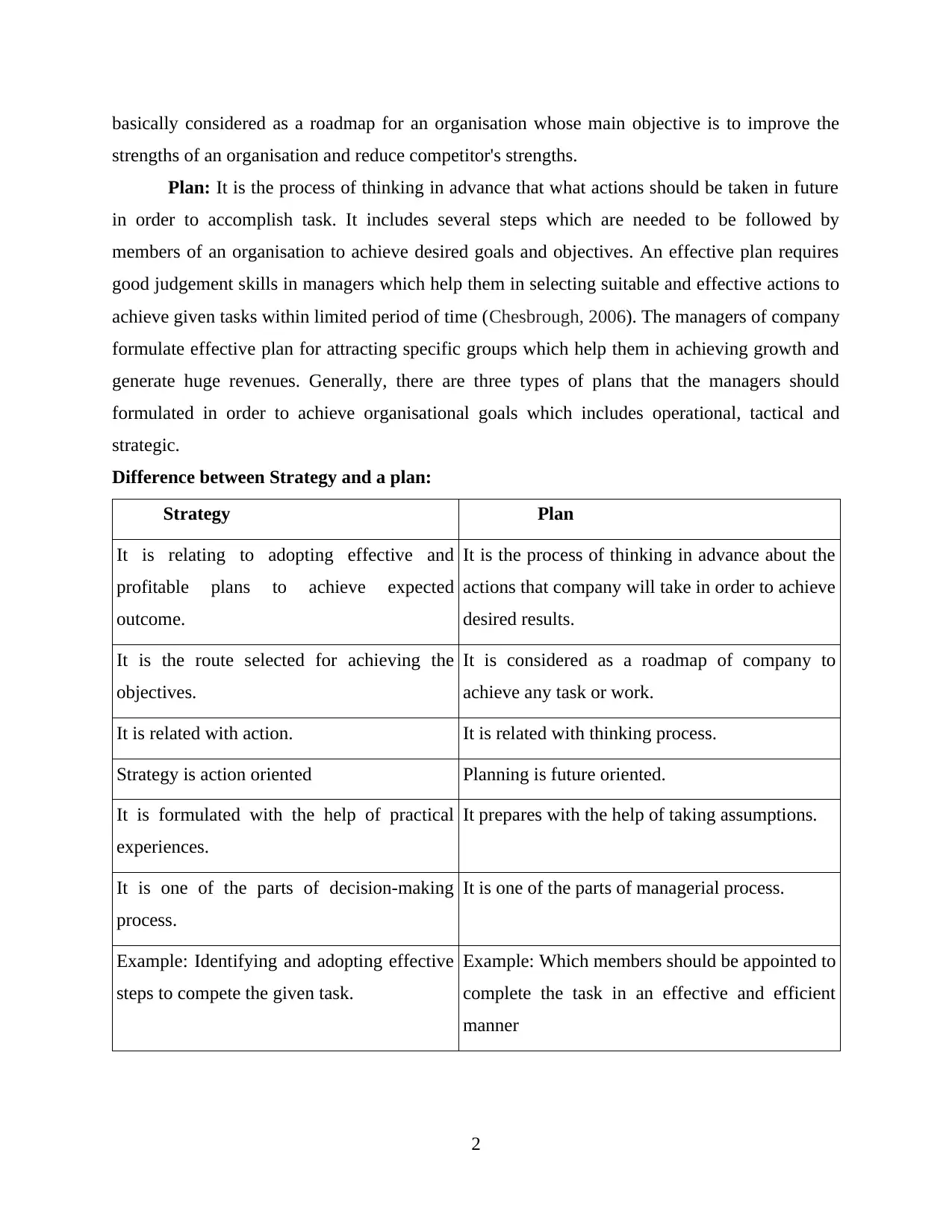
basically considered as a roadmap for an organisation whose main objective is to improve the
strengths of an organisation and reduce competitor's strengths.
Plan: It is the process of thinking in advance that what actions should be taken in future
in order to accomplish task. It includes several steps which are needed to be followed by
members of an organisation to achieve desired goals and objectives. An effective plan requires
good judgement skills in managers which help them in selecting suitable and effective actions to
achieve given tasks within limited period of time (Chesbrough, 2006). The managers of company
formulate effective plan for attracting specific groups which help them in achieving growth and
generate huge revenues. Generally, there are three types of plans that the managers should
formulated in order to achieve organisational goals which includes operational, tactical and
strategic.
Difference between Strategy and a plan:
Strategy Plan
It is relating to adopting effective and
profitable plans to achieve expected
outcome.
It is the process of thinking in advance about the
actions that company will take in order to achieve
desired results.
It is the route selected for achieving the
objectives.
It is considered as a roadmap of company to
achieve any task or work.
It is related with action. It is related with thinking process.
Strategy is action oriented Planning is future oriented.
It is formulated with the help of practical
experiences.
It prepares with the help of taking assumptions.
It is one of the parts of decision-making
process.
It is one of the parts of managerial process.
Example: Identifying and adopting effective
steps to compete the given task.
Example: Which members should be appointed to
complete the task in an effective and efficient
manner
2
strengths of an organisation and reduce competitor's strengths.
Plan: It is the process of thinking in advance that what actions should be taken in future
in order to accomplish task. It includes several steps which are needed to be followed by
members of an organisation to achieve desired goals and objectives. An effective plan requires
good judgement skills in managers which help them in selecting suitable and effective actions to
achieve given tasks within limited period of time (Chesbrough, 2006). The managers of company
formulate effective plan for attracting specific groups which help them in achieving growth and
generate huge revenues. Generally, there are three types of plans that the managers should
formulated in order to achieve organisational goals which includes operational, tactical and
strategic.
Difference between Strategy and a plan:
Strategy Plan
It is relating to adopting effective and
profitable plans to achieve expected
outcome.
It is the process of thinking in advance about the
actions that company will take in order to achieve
desired results.
It is the route selected for achieving the
objectives.
It is considered as a roadmap of company to
achieve any task or work.
It is related with action. It is related with thinking process.
Strategy is action oriented Planning is future oriented.
It is formulated with the help of practical
experiences.
It prepares with the help of taking assumptions.
It is one of the parts of decision-making
process.
It is one of the parts of managerial process.
Example: Identifying and adopting effective
steps to compete the given task.
Example: Which members should be appointed to
complete the task in an effective and efficient
manner
2
Paraphrase This Document
Need a fresh take? Get an instant paraphrase of this document with our AI Paraphraser
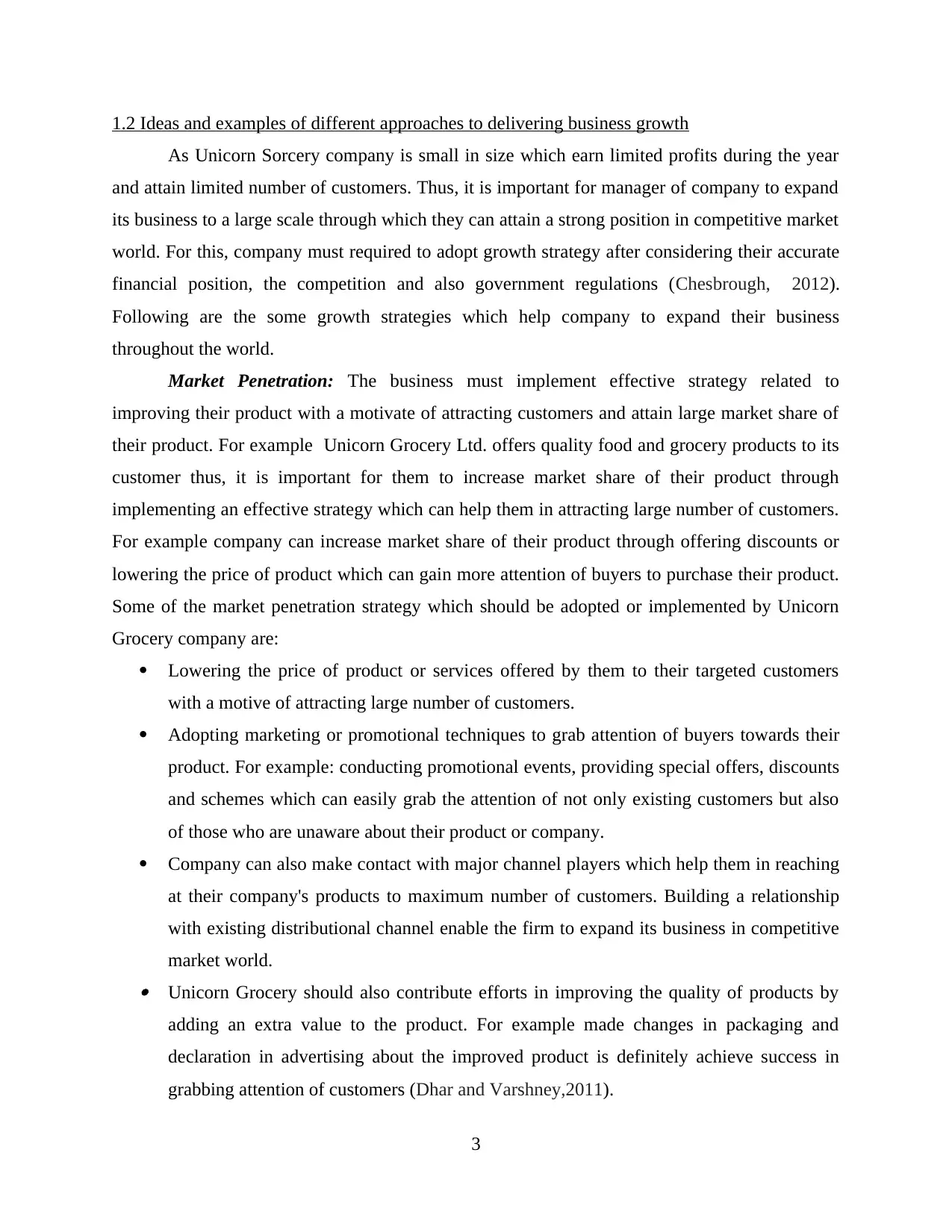
1.2 Ideas and examples of different approaches to delivering business growth
As Unicorn Sorcery company is small in size which earn limited profits during the year
and attain limited number of customers. Thus, it is important for manager of company to expand
its business to a large scale through which they can attain a strong position in competitive market
world. For this, company must required to adopt growth strategy after considering their accurate
financial position, the competition and also government regulations (Chesbrough, 2012).
Following are the some growth strategies which help company to expand their business
throughout the world.
Market Penetration: The business must implement effective strategy related to
improving their product with a motivate of attracting customers and attain large market share of
their product. For example Unicorn Grocery Ltd. offers quality food and grocery products to its
customer thus, it is important for them to increase market share of their product through
implementing an effective strategy which can help them in attracting large number of customers.
For example company can increase market share of their product through offering discounts or
lowering the price of product which can gain more attention of buyers to purchase their product.
Some of the market penetration strategy which should be adopted or implemented by Unicorn
Grocery company are:
Lowering the price of product or services offered by them to their targeted customers
with a motive of attracting large number of customers.
Adopting marketing or promotional techniques to grab attention of buyers towards their
product. For example: conducting promotional events, providing special offers, discounts
and schemes which can easily grab the attention of not only existing customers but also
of those who are unaware about their product or company.
Company can also make contact with major channel players which help them in reaching
at their company's products to maximum number of customers. Building a relationship
with existing distributional channel enable the firm to expand its business in competitive
market world. Unicorn Grocery should also contribute efforts in improving the quality of products by
adding an extra value to the product. For example made changes in packaging and
declaration in advertising about the improved product is definitely achieve success in
grabbing attention of customers (Dhar and Varshney,2011).
3
As Unicorn Sorcery company is small in size which earn limited profits during the year
and attain limited number of customers. Thus, it is important for manager of company to expand
its business to a large scale through which they can attain a strong position in competitive market
world. For this, company must required to adopt growth strategy after considering their accurate
financial position, the competition and also government regulations (Chesbrough, 2012).
Following are the some growth strategies which help company to expand their business
throughout the world.
Market Penetration: The business must implement effective strategy related to
improving their product with a motivate of attracting customers and attain large market share of
their product. For example Unicorn Grocery Ltd. offers quality food and grocery products to its
customer thus, it is important for them to increase market share of their product through
implementing an effective strategy which can help them in attracting large number of customers.
For example company can increase market share of their product through offering discounts or
lowering the price of product which can gain more attention of buyers to purchase their product.
Some of the market penetration strategy which should be adopted or implemented by Unicorn
Grocery company are:
Lowering the price of product or services offered by them to their targeted customers
with a motive of attracting large number of customers.
Adopting marketing or promotional techniques to grab attention of buyers towards their
product. For example: conducting promotional events, providing special offers, discounts
and schemes which can easily grab the attention of not only existing customers but also
of those who are unaware about their product or company.
Company can also make contact with major channel players which help them in reaching
at their company's products to maximum number of customers. Building a relationship
with existing distributional channel enable the firm to expand its business in competitive
market world. Unicorn Grocery should also contribute efforts in improving the quality of products by
adding an extra value to the product. For example made changes in packaging and
declaration in advertising about the improved product is definitely achieve success in
grabbing attention of customers (Dhar and Varshney,2011).
3
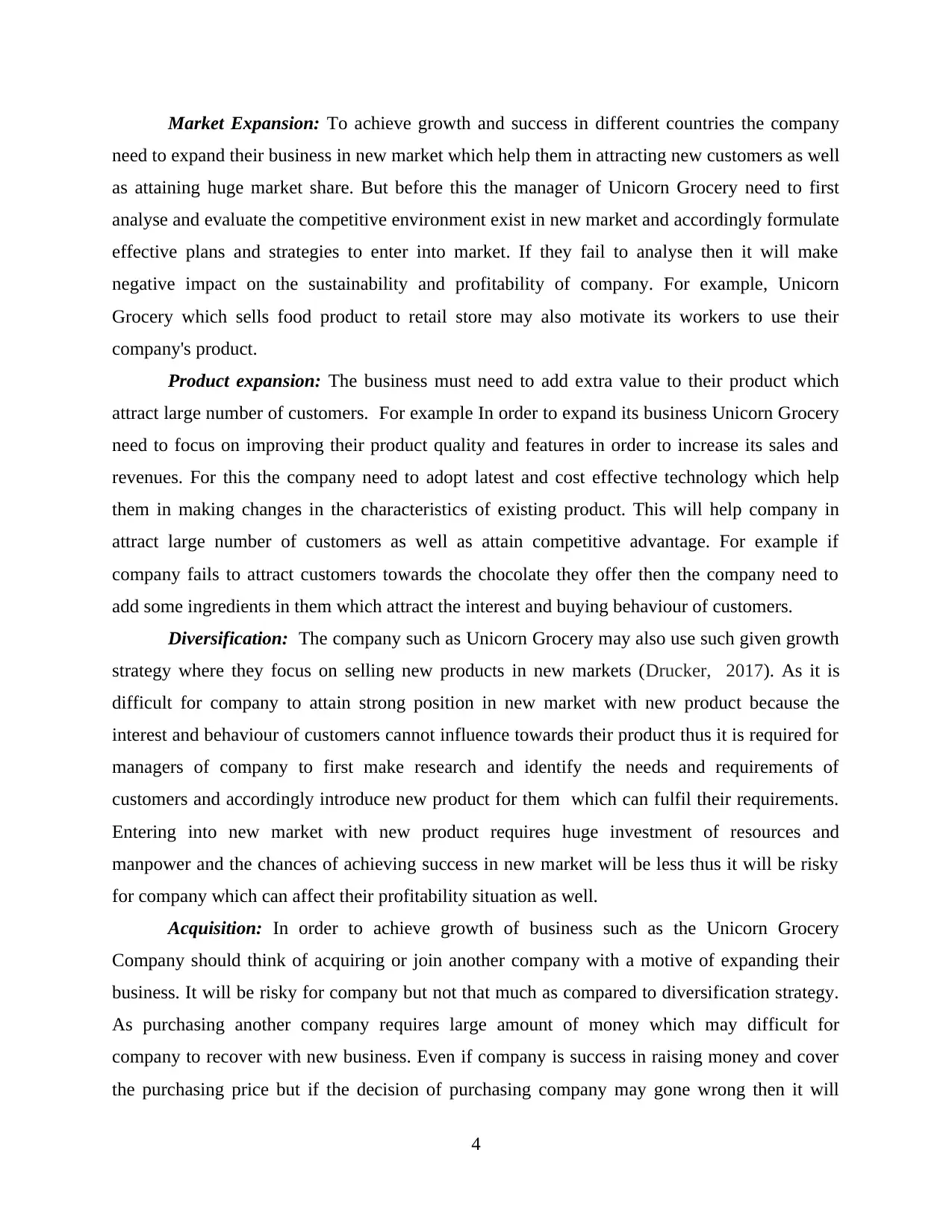
Market Expansion: To achieve growth and success in different countries the company
need to expand their business in new market which help them in attracting new customers as well
as attaining huge market share. But before this the manager of Unicorn Grocery need to first
analyse and evaluate the competitive environment exist in new market and accordingly formulate
effective plans and strategies to enter into market. If they fail to analyse then it will make
negative impact on the sustainability and profitability of company. For example, Unicorn
Grocery which sells food product to retail store may also motivate its workers to use their
company's product.
Product expansion: The business must need to add extra value to their product which
attract large number of customers. For example In order to expand its business Unicorn Grocery
need to focus on improving their product quality and features in order to increase its sales and
revenues. For this the company need to adopt latest and cost effective technology which help
them in making changes in the characteristics of existing product. This will help company in
attract large number of customers as well as attain competitive advantage. For example if
company fails to attract customers towards the chocolate they offer then the company need to
add some ingredients in them which attract the interest and buying behaviour of customers.
Diversification: The company such as Unicorn Grocery may also use such given growth
strategy where they focus on selling new products in new markets (Drucker, 2017). As it is
difficult for company to attain strong position in new market with new product because the
interest and behaviour of customers cannot influence towards their product thus it is required for
managers of company to first make research and identify the needs and requirements of
customers and accordingly introduce new product for them which can fulfil their requirements.
Entering into new market with new product requires huge investment of resources and
manpower and the chances of achieving success in new market will be less thus it will be risky
for company which can affect their profitability situation as well.
Acquisition: In order to achieve growth of business such as the Unicorn Grocery
Company should think of acquiring or join another company with a motive of expanding their
business. It will be risky for company but not that much as compared to diversification strategy.
As purchasing another company requires large amount of money which may difficult for
company to recover with new business. Even if company is success in raising money and cover
the purchasing price but if the decision of purchasing company may gone wrong then it will
4
need to expand their business in new market which help them in attracting new customers as well
as attaining huge market share. But before this the manager of Unicorn Grocery need to first
analyse and evaluate the competitive environment exist in new market and accordingly formulate
effective plans and strategies to enter into market. If they fail to analyse then it will make
negative impact on the sustainability and profitability of company. For example, Unicorn
Grocery which sells food product to retail store may also motivate its workers to use their
company's product.
Product expansion: The business must need to add extra value to their product which
attract large number of customers. For example In order to expand its business Unicorn Grocery
need to focus on improving their product quality and features in order to increase its sales and
revenues. For this the company need to adopt latest and cost effective technology which help
them in making changes in the characteristics of existing product. This will help company in
attract large number of customers as well as attain competitive advantage. For example if
company fails to attract customers towards the chocolate they offer then the company need to
add some ingredients in them which attract the interest and buying behaviour of customers.
Diversification: The company such as Unicorn Grocery may also use such given growth
strategy where they focus on selling new products in new markets (Drucker, 2017). As it is
difficult for company to attain strong position in new market with new product because the
interest and behaviour of customers cannot influence towards their product thus it is required for
managers of company to first make research and identify the needs and requirements of
customers and accordingly introduce new product for them which can fulfil their requirements.
Entering into new market with new product requires huge investment of resources and
manpower and the chances of achieving success in new market will be less thus it will be risky
for company which can affect their profitability situation as well.
Acquisition: In order to achieve growth of business such as the Unicorn Grocery
Company should think of acquiring or join another company with a motive of expanding their
business. It will be risky for company but not that much as compared to diversification strategy.
As purchasing another company requires large amount of money which may difficult for
company to recover with new business. Even if company is success in raising money and cover
the purchasing price but if the decision of purchasing company may gone wrong then it will
4
⊘ This is a preview!⊘
Do you want full access?
Subscribe today to unlock all pages.

Trusted by 1+ million students worldwide
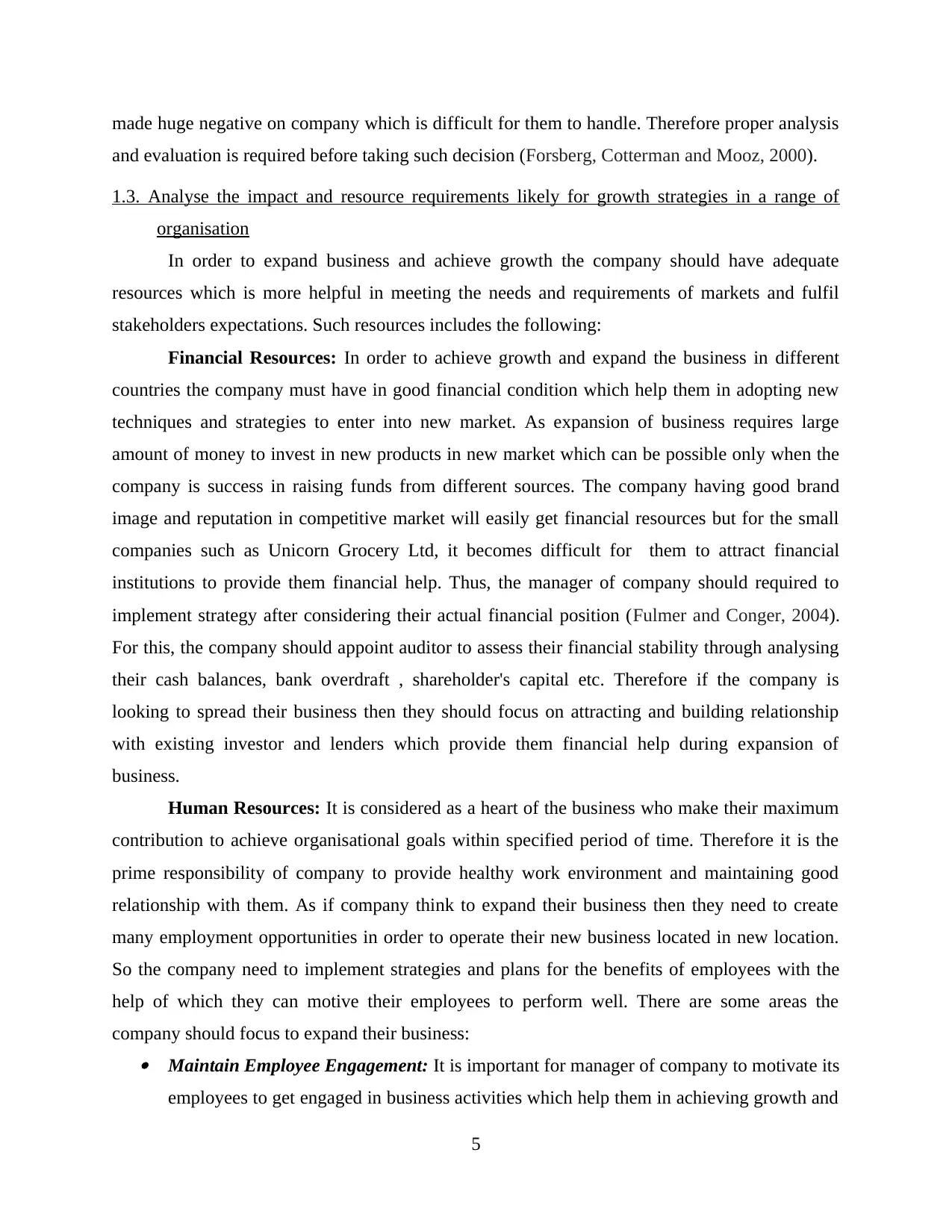
made huge negative on company which is difficult for them to handle. Therefore proper analysis
and evaluation is required before taking such decision (Forsberg, Cotterman and Mooz, 2000).
1.3. Analyse the impact and resource requirements likely for growth strategies in a range of
organisation
In order to expand business and achieve growth the company should have adequate
resources which is more helpful in meeting the needs and requirements of markets and fulfil
stakeholders expectations. Such resources includes the following:
Financial Resources: In order to achieve growth and expand the business in different
countries the company must have in good financial condition which help them in adopting new
techniques and strategies to enter into new market. As expansion of business requires large
amount of money to invest in new products in new market which can be possible only when the
company is success in raising funds from different sources. The company having good brand
image and reputation in competitive market will easily get financial resources but for the small
companies such as Unicorn Grocery Ltd, it becomes difficult for them to attract financial
institutions to provide them financial help. Thus, the manager of company should required to
implement strategy after considering their actual financial position (Fulmer and Conger, 2004).
For this, the company should appoint auditor to assess their financial stability through analysing
their cash balances, bank overdraft , shareholder's capital etc. Therefore if the company is
looking to spread their business then they should focus on attracting and building relationship
with existing investor and lenders which provide them financial help during expansion of
business.
Human Resources: It is considered as a heart of the business who make their maximum
contribution to achieve organisational goals within specified period of time. Therefore it is the
prime responsibility of company to provide healthy work environment and maintaining good
relationship with them. As if company think to expand their business then they need to create
many employment opportunities in order to operate their new business located in new location.
So the company need to implement strategies and plans for the benefits of employees with the
help of which they can motive their employees to perform well. There are some areas the
company should focus to expand their business: Maintain Employee Engagement: It is important for manager of company to motivate its
employees to get engaged in business activities which help them in achieving growth and
5
and evaluation is required before taking such decision (Forsberg, Cotterman and Mooz, 2000).
1.3. Analyse the impact and resource requirements likely for growth strategies in a range of
organisation
In order to expand business and achieve growth the company should have adequate
resources which is more helpful in meeting the needs and requirements of markets and fulfil
stakeholders expectations. Such resources includes the following:
Financial Resources: In order to achieve growth and expand the business in different
countries the company must have in good financial condition which help them in adopting new
techniques and strategies to enter into new market. As expansion of business requires large
amount of money to invest in new products in new market which can be possible only when the
company is success in raising funds from different sources. The company having good brand
image and reputation in competitive market will easily get financial resources but for the small
companies such as Unicorn Grocery Ltd, it becomes difficult for them to attract financial
institutions to provide them financial help. Thus, the manager of company should required to
implement strategy after considering their actual financial position (Fulmer and Conger, 2004).
For this, the company should appoint auditor to assess their financial stability through analysing
their cash balances, bank overdraft , shareholder's capital etc. Therefore if the company is
looking to spread their business then they should focus on attracting and building relationship
with existing investor and lenders which provide them financial help during expansion of
business.
Human Resources: It is considered as a heart of the business who make their maximum
contribution to achieve organisational goals within specified period of time. Therefore it is the
prime responsibility of company to provide healthy work environment and maintaining good
relationship with them. As if company think to expand their business then they need to create
many employment opportunities in order to operate their new business located in new location.
So the company need to implement strategies and plans for the benefits of employees with the
help of which they can motive their employees to perform well. There are some areas the
company should focus to expand their business: Maintain Employee Engagement: It is important for manager of company to motivate its
employees to get engaged in business activities which help them in achieving growth and
5
Paraphrase This Document
Need a fresh take? Get an instant paraphrase of this document with our AI Paraphraser
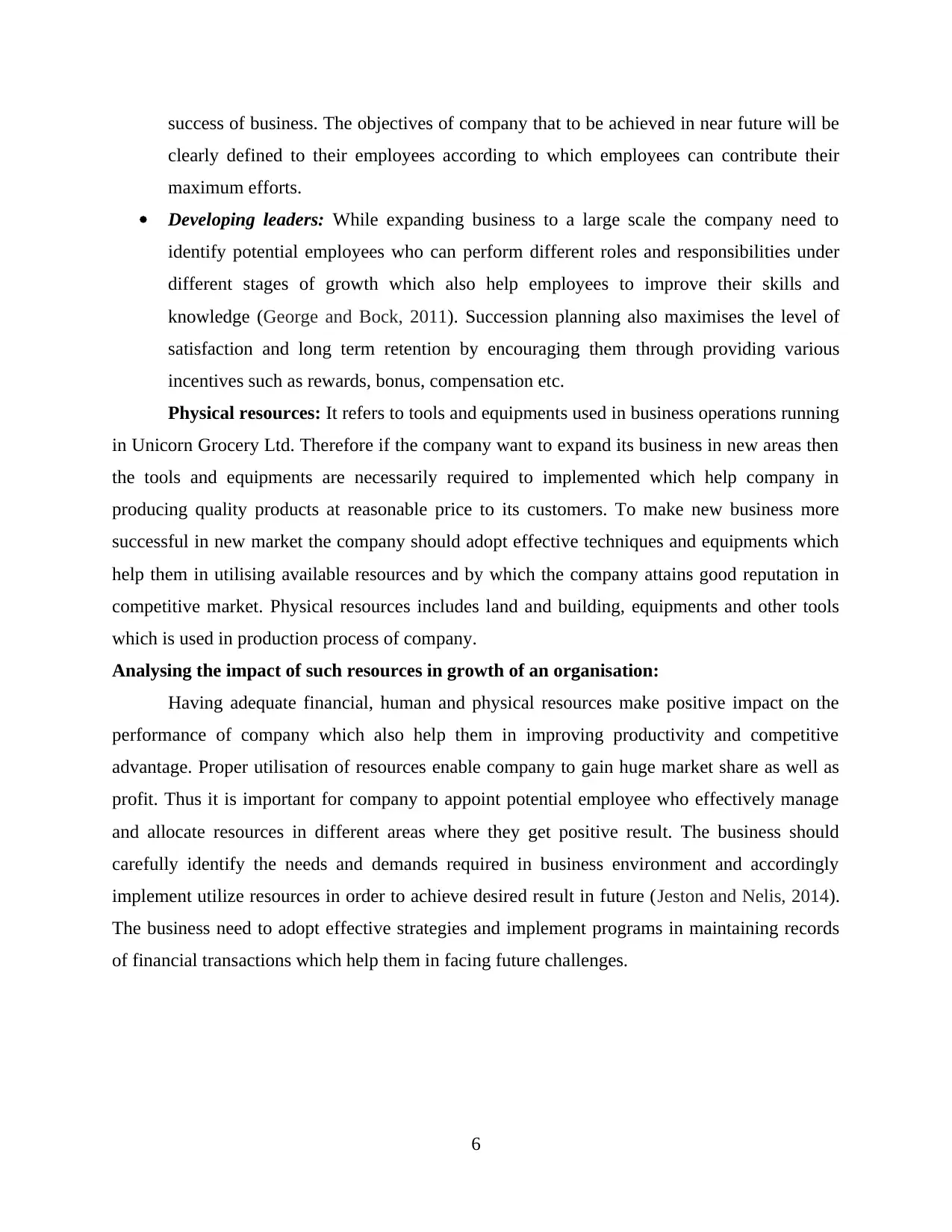
success of business. The objectives of company that to be achieved in near future will be
clearly defined to their employees according to which employees can contribute their
maximum efforts.
Developing leaders: While expanding business to a large scale the company need to
identify potential employees who can perform different roles and responsibilities under
different stages of growth which also help employees to improve their skills and
knowledge (George and Bock, 2011). Succession planning also maximises the level of
satisfaction and long term retention by encouraging them through providing various
incentives such as rewards, bonus, compensation etc.
Physical resources: It refers to tools and equipments used in business operations running
in Unicorn Grocery Ltd. Therefore if the company want to expand its business in new areas then
the tools and equipments are necessarily required to implemented which help company in
producing quality products at reasonable price to its customers. To make new business more
successful in new market the company should adopt effective techniques and equipments which
help them in utilising available resources and by which the company attains good reputation in
competitive market. Physical resources includes land and building, equipments and other tools
which is used in production process of company.
Analysing the impact of such resources in growth of an organisation:
Having adequate financial, human and physical resources make positive impact on the
performance of company which also help them in improving productivity and competitive
advantage. Proper utilisation of resources enable company to gain huge market share as well as
profit. Thus it is important for company to appoint potential employee who effectively manage
and allocate resources in different areas where they get positive result. The business should
carefully identify the needs and demands required in business environment and accordingly
implement utilize resources in order to achieve desired result in future (Jeston and Nelis, 2014).
The business need to adopt effective strategies and implement programs in maintaining records
of financial transactions which help them in facing future challenges.
6
clearly defined to their employees according to which employees can contribute their
maximum efforts.
Developing leaders: While expanding business to a large scale the company need to
identify potential employees who can perform different roles and responsibilities under
different stages of growth which also help employees to improve their skills and
knowledge (George and Bock, 2011). Succession planning also maximises the level of
satisfaction and long term retention by encouraging them through providing various
incentives such as rewards, bonus, compensation etc.
Physical resources: It refers to tools and equipments used in business operations running
in Unicorn Grocery Ltd. Therefore if the company want to expand its business in new areas then
the tools and equipments are necessarily required to implemented which help company in
producing quality products at reasonable price to its customers. To make new business more
successful in new market the company should adopt effective techniques and equipments which
help them in utilising available resources and by which the company attains good reputation in
competitive market. Physical resources includes land and building, equipments and other tools
which is used in production process of company.
Analysing the impact of such resources in growth of an organisation:
Having adequate financial, human and physical resources make positive impact on the
performance of company which also help them in improving productivity and competitive
advantage. Proper utilisation of resources enable company to gain huge market share as well as
profit. Thus it is important for company to appoint potential employee who effectively manage
and allocate resources in different areas where they get positive result. The business should
carefully identify the needs and demands required in business environment and accordingly
implement utilize resources in order to achieve desired result in future (Jeston and Nelis, 2014).
The business need to adopt effective strategies and implement programs in maintaining records
of financial transactions which help them in facing future challenges.
6
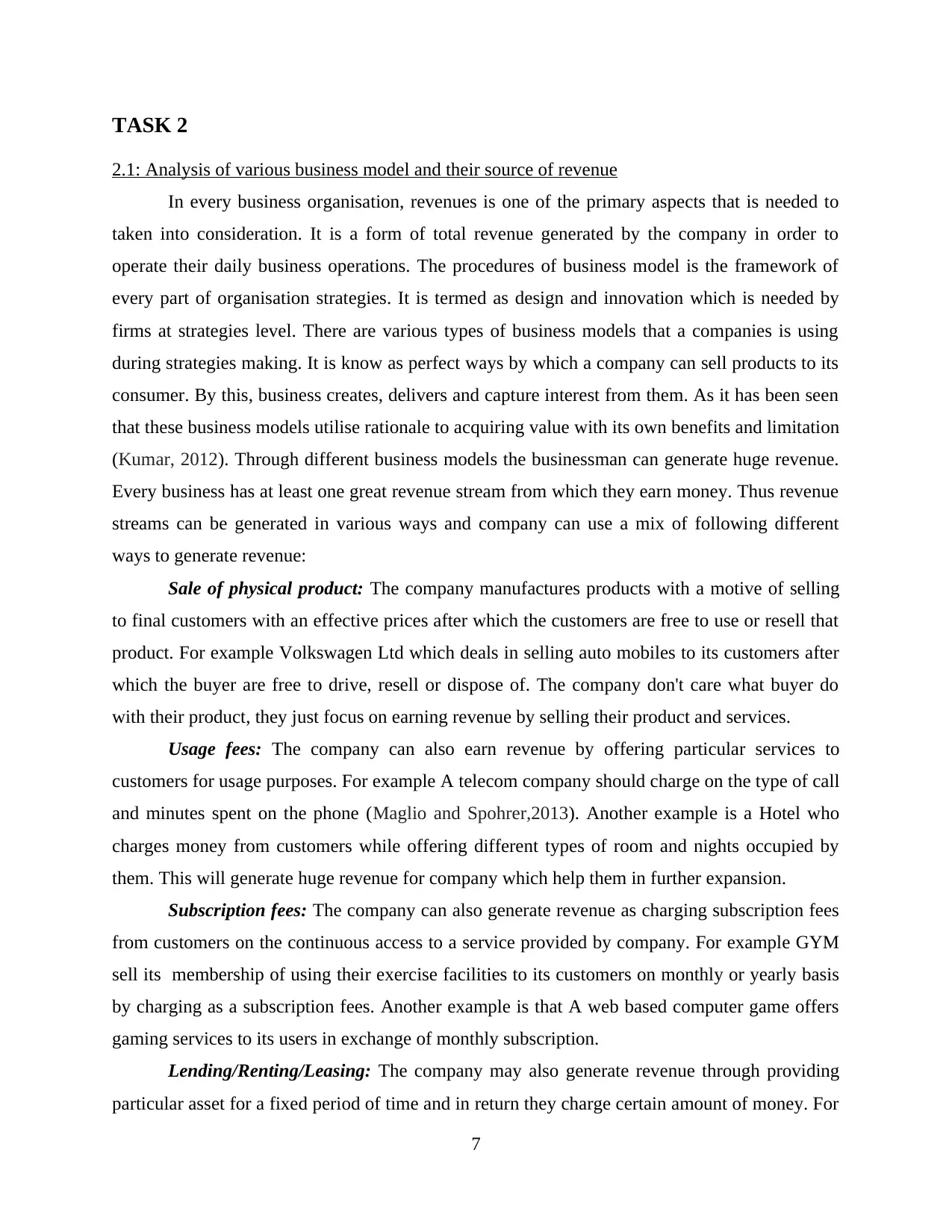
TASK 2
2.1: Analysis of various business model and their source of revenue
In every business organisation, revenues is one of the primary aspects that is needed to
taken into consideration. It is a form of total revenue generated by the company in order to
operate their daily business operations. The procedures of business model is the framework of
every part of organisation strategies. It is termed as design and innovation which is needed by
firms at strategies level. There are various types of business models that a companies is using
during strategies making. It is know as perfect ways by which a company can sell products to its
consumer. By this, business creates, delivers and capture interest from them. As it has been seen
that these business models utilise rationale to acquiring value with its own benefits and limitation
(Kumar, 2012). Through different business models the businessman can generate huge revenue.
Every business has at least one great revenue stream from which they earn money. Thus revenue
streams can be generated in various ways and company can use a mix of following different
ways to generate revenue:
Sale of physical product: The company manufactures products with a motive of selling
to final customers with an effective prices after which the customers are free to use or resell that
product. For example Volkswagen Ltd which deals in selling auto mobiles to its customers after
which the buyer are free to drive, resell or dispose of. The company don't care what buyer do
with their product, they just focus on earning revenue by selling their product and services.
Usage fees: The company can also earn revenue by offering particular services to
customers for usage purposes. For example A telecom company should charge on the type of call
and minutes spent on the phone (Maglio and Spohrer,2013). Another example is a Hotel who
charges money from customers while offering different types of room and nights occupied by
them. This will generate huge revenue for company which help them in further expansion.
Subscription fees: The company can also generate revenue as charging subscription fees
from customers on the continuous access to a service provided by company. For example GYM
sell its membership of using their exercise facilities to its customers on monthly or yearly basis
by charging as a subscription fees. Another example is that A web based computer game offers
gaming services to its users in exchange of monthly subscription.
Lending/Renting/Leasing: The company may also generate revenue through providing
particular asset for a fixed period of time and in return they charge certain amount of money. For
7
2.1: Analysis of various business model and their source of revenue
In every business organisation, revenues is one of the primary aspects that is needed to
taken into consideration. It is a form of total revenue generated by the company in order to
operate their daily business operations. The procedures of business model is the framework of
every part of organisation strategies. It is termed as design and innovation which is needed by
firms at strategies level. There are various types of business models that a companies is using
during strategies making. It is know as perfect ways by which a company can sell products to its
consumer. By this, business creates, delivers and capture interest from them. As it has been seen
that these business models utilise rationale to acquiring value with its own benefits and limitation
(Kumar, 2012). Through different business models the businessman can generate huge revenue.
Every business has at least one great revenue stream from which they earn money. Thus revenue
streams can be generated in various ways and company can use a mix of following different
ways to generate revenue:
Sale of physical product: The company manufactures products with a motive of selling
to final customers with an effective prices after which the customers are free to use or resell that
product. For example Volkswagen Ltd which deals in selling auto mobiles to its customers after
which the buyer are free to drive, resell or dispose of. The company don't care what buyer do
with their product, they just focus on earning revenue by selling their product and services.
Usage fees: The company can also earn revenue by offering particular services to
customers for usage purposes. For example A telecom company should charge on the type of call
and minutes spent on the phone (Maglio and Spohrer,2013). Another example is a Hotel who
charges money from customers while offering different types of room and nights occupied by
them. This will generate huge revenue for company which help them in further expansion.
Subscription fees: The company can also generate revenue as charging subscription fees
from customers on the continuous access to a service provided by company. For example GYM
sell its membership of using their exercise facilities to its customers on monthly or yearly basis
by charging as a subscription fees. Another example is that A web based computer game offers
gaming services to its users in exchange of monthly subscription.
Lending/Renting/Leasing: The company may also generate revenue through providing
particular asset for a fixed period of time and in return they charge certain amount of money. For
7
⊘ This is a preview!⊘
Do you want full access?
Subscribe today to unlock all pages.

Trusted by 1+ million students worldwide
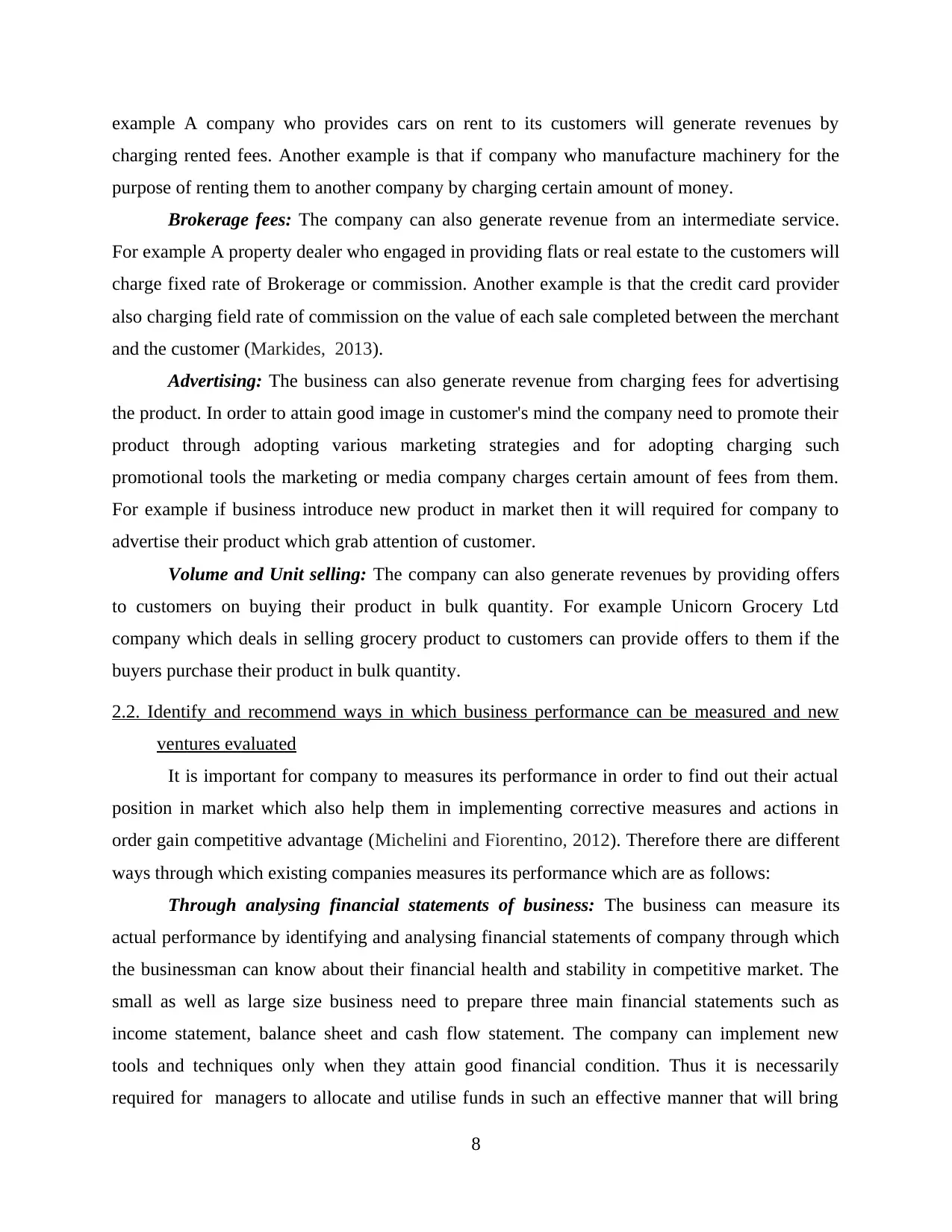
example A company who provides cars on rent to its customers will generate revenues by
charging rented fees. Another example is that if company who manufacture machinery for the
purpose of renting them to another company by charging certain amount of money.
Brokerage fees: The company can also generate revenue from an intermediate service.
For example A property dealer who engaged in providing flats or real estate to the customers will
charge fixed rate of Brokerage or commission. Another example is that the credit card provider
also charging field rate of commission on the value of each sale completed between the merchant
and the customer (Markides, 2013).
Advertising: The business can also generate revenue from charging fees for advertising
the product. In order to attain good image in customer's mind the company need to promote their
product through adopting various marketing strategies and for adopting charging such
promotional tools the marketing or media company charges certain amount of fees from them.
For example if business introduce new product in market then it will required for company to
advertise their product which grab attention of customer.
Volume and Unit selling: The company can also generate revenues by providing offers
to customers on buying their product in bulk quantity. For example Unicorn Grocery Ltd
company which deals in selling grocery product to customers can provide offers to them if the
buyers purchase their product in bulk quantity.
2.2. Identify and recommend ways in which business performance can be measured and new
ventures evaluated
It is important for company to measures its performance in order to find out their actual
position in market which also help them in implementing corrective measures and actions in
order gain competitive advantage (Michelini and Fiorentino, 2012). Therefore there are different
ways through which existing companies measures its performance which are as follows:
Through analysing financial statements of business: The business can measure its
actual performance by identifying and analysing financial statements of company through which
the businessman can know about their financial health and stability in competitive market. The
small as well as large size business need to prepare three main financial statements such as
income statement, balance sheet and cash flow statement. The company can implement new
tools and techniques only when they attain good financial condition. Thus it is necessarily
required for managers to allocate and utilise funds in such an effective manner that will bring
8
charging rented fees. Another example is that if company who manufacture machinery for the
purpose of renting them to another company by charging certain amount of money.
Brokerage fees: The company can also generate revenue from an intermediate service.
For example A property dealer who engaged in providing flats or real estate to the customers will
charge fixed rate of Brokerage or commission. Another example is that the credit card provider
also charging field rate of commission on the value of each sale completed between the merchant
and the customer (Markides, 2013).
Advertising: The business can also generate revenue from charging fees for advertising
the product. In order to attain good image in customer's mind the company need to promote their
product through adopting various marketing strategies and for adopting charging such
promotional tools the marketing or media company charges certain amount of fees from them.
For example if business introduce new product in market then it will required for company to
advertise their product which grab attention of customer.
Volume and Unit selling: The company can also generate revenues by providing offers
to customers on buying their product in bulk quantity. For example Unicorn Grocery Ltd
company which deals in selling grocery product to customers can provide offers to them if the
buyers purchase their product in bulk quantity.
2.2. Identify and recommend ways in which business performance can be measured and new
ventures evaluated
It is important for company to measures its performance in order to find out their actual
position in market which also help them in implementing corrective measures and actions in
order gain competitive advantage (Michelini and Fiorentino, 2012). Therefore there are different
ways through which existing companies measures its performance which are as follows:
Through analysing financial statements of business: The business can measure its
actual performance by identifying and analysing financial statements of company through which
the businessman can know about their financial health and stability in competitive market. The
small as well as large size business need to prepare three main financial statements such as
income statement, balance sheet and cash flow statement. The company can implement new
tools and techniques only when they attain good financial condition. Thus it is necessarily
required for managers to allocate and utilise funds in such an effective manner that will bring
8
Paraphrase This Document
Need a fresh take? Get an instant paraphrase of this document with our AI Paraphraser
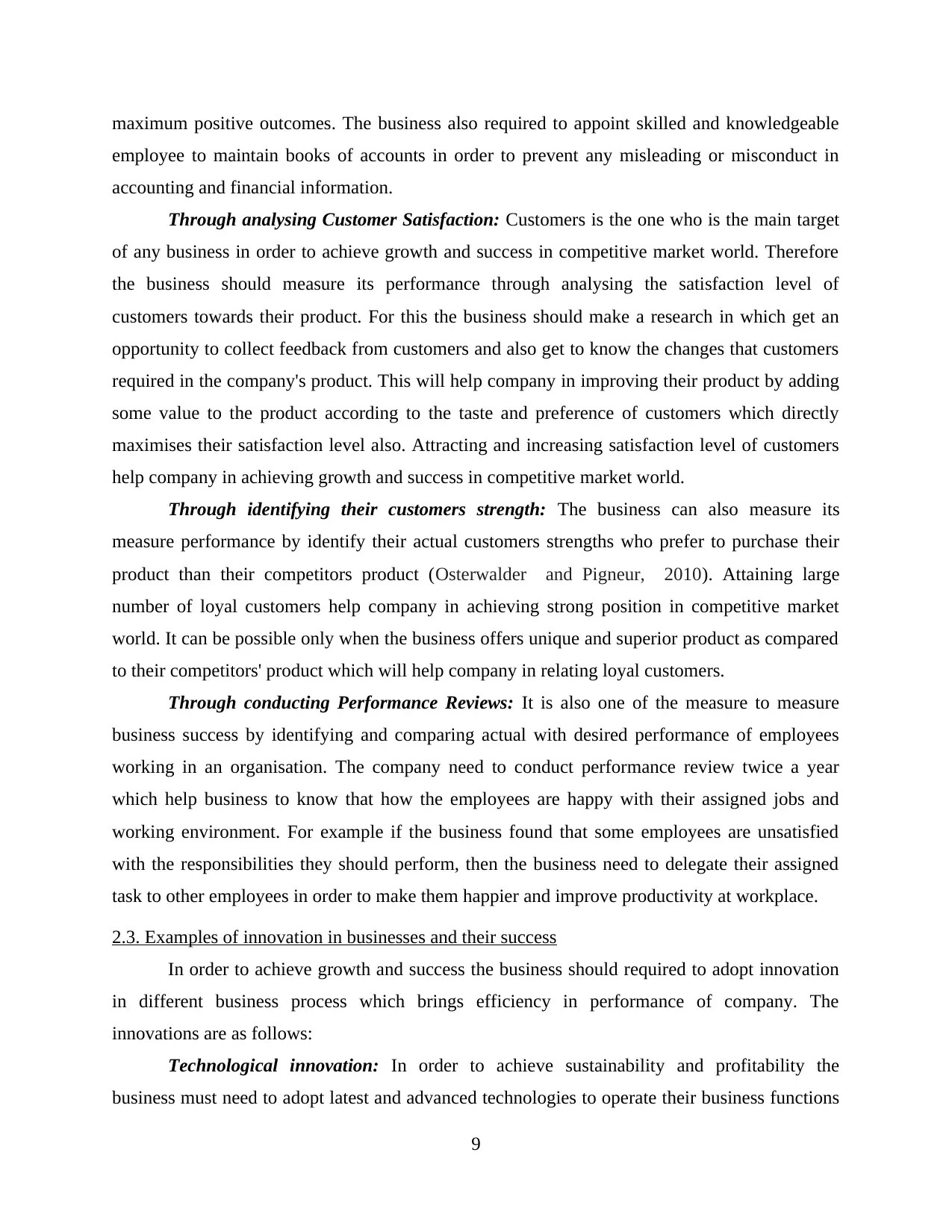
maximum positive outcomes. The business also required to appoint skilled and knowledgeable
employee to maintain books of accounts in order to prevent any misleading or misconduct in
accounting and financial information.
Through analysing Customer Satisfaction: Customers is the one who is the main target
of any business in order to achieve growth and success in competitive market world. Therefore
the business should measure its performance through analysing the satisfaction level of
customers towards their product. For this the business should make a research in which get an
opportunity to collect feedback from customers and also get to know the changes that customers
required in the company's product. This will help company in improving their product by adding
some value to the product according to the taste and preference of customers which directly
maximises their satisfaction level also. Attracting and increasing satisfaction level of customers
help company in achieving growth and success in competitive market world.
Through identifying their customers strength: The business can also measure its
measure performance by identify their actual customers strengths who prefer to purchase their
product than their competitors product (Osterwalder and Pigneur, 2010). Attaining large
number of loyal customers help company in achieving strong position in competitive market
world. It can be possible only when the business offers unique and superior product as compared
to their competitors' product which will help company in relating loyal customers.
Through conducting Performance Reviews: It is also one of the measure to measure
business success by identifying and comparing actual with desired performance of employees
working in an organisation. The company need to conduct performance review twice a year
which help business to know that how the employees are happy with their assigned jobs and
working environment. For example if the business found that some employees are unsatisfied
with the responsibilities they should perform, then the business need to delegate their assigned
task to other employees in order to make them happier and improve productivity at workplace.
2.3. Examples of innovation in businesses and their success
In order to achieve growth and success the business should required to adopt innovation
in different business process which brings efficiency in performance of company. The
innovations are as follows:
Technological innovation: In order to achieve sustainability and profitability the
business must need to adopt latest and advanced technologies to operate their business functions
9
employee to maintain books of accounts in order to prevent any misleading or misconduct in
accounting and financial information.
Through analysing Customer Satisfaction: Customers is the one who is the main target
of any business in order to achieve growth and success in competitive market world. Therefore
the business should measure its performance through analysing the satisfaction level of
customers towards their product. For this the business should make a research in which get an
opportunity to collect feedback from customers and also get to know the changes that customers
required in the company's product. This will help company in improving their product by adding
some value to the product according to the taste and preference of customers which directly
maximises their satisfaction level also. Attracting and increasing satisfaction level of customers
help company in achieving growth and success in competitive market world.
Through identifying their customers strength: The business can also measure its
measure performance by identify their actual customers strengths who prefer to purchase their
product than their competitors product (Osterwalder and Pigneur, 2010). Attaining large
number of loyal customers help company in achieving strong position in competitive market
world. It can be possible only when the business offers unique and superior product as compared
to their competitors' product which will help company in relating loyal customers.
Through conducting Performance Reviews: It is also one of the measure to measure
business success by identifying and comparing actual with desired performance of employees
working in an organisation. The company need to conduct performance review twice a year
which help business to know that how the employees are happy with their assigned jobs and
working environment. For example if the business found that some employees are unsatisfied
with the responsibilities they should perform, then the business need to delegate their assigned
task to other employees in order to make them happier and improve productivity at workplace.
2.3. Examples of innovation in businesses and their success
In order to achieve growth and success the business should required to adopt innovation
in different business process which brings efficiency in performance of company. The
innovations are as follows:
Technological innovation: In order to achieve sustainability and profitability the
business must need to adopt latest and advanced technologies to operate their business functions
9
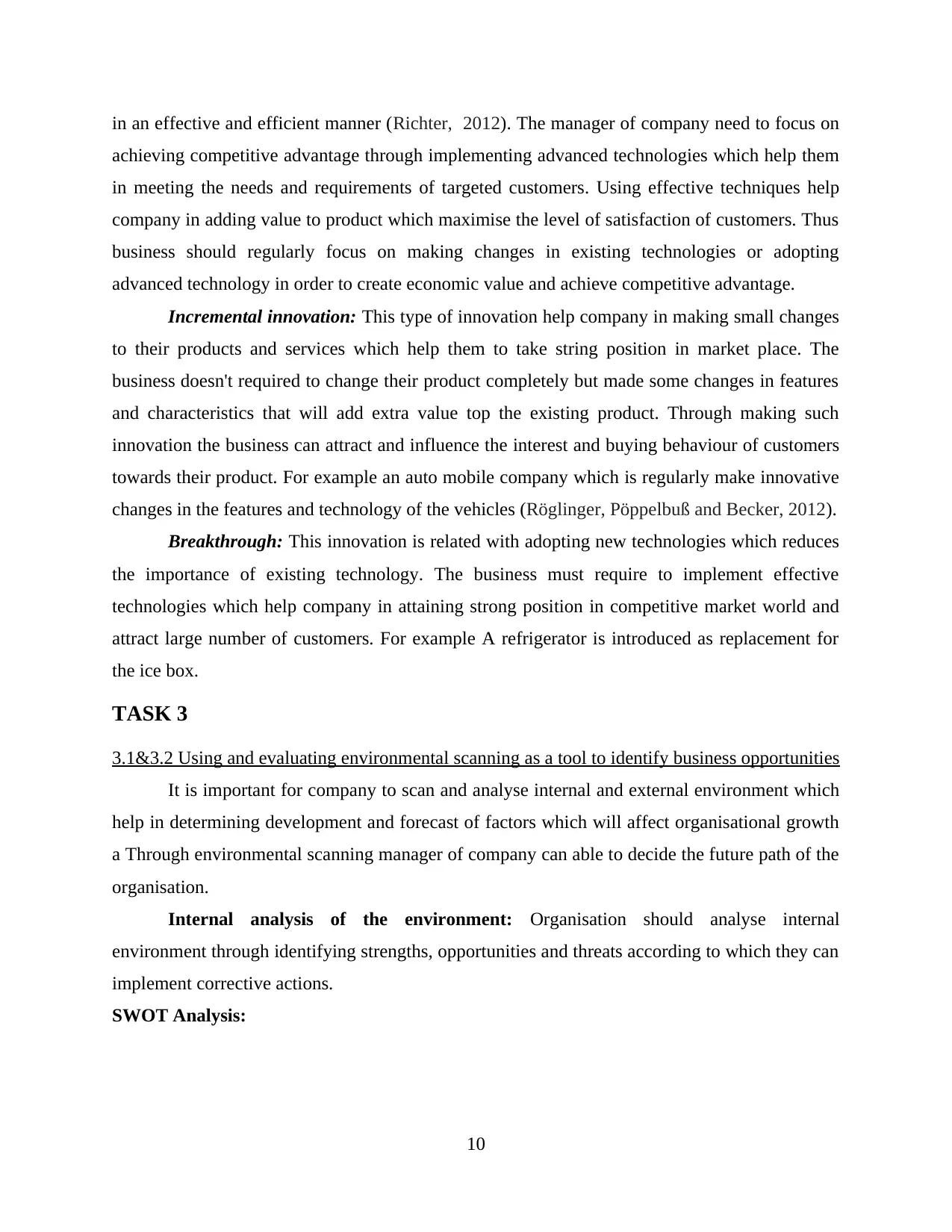
in an effective and efficient manner (Richter, 2012). The manager of company need to focus on
achieving competitive advantage through implementing advanced technologies which help them
in meeting the needs and requirements of targeted customers. Using effective techniques help
company in adding value to product which maximise the level of satisfaction of customers. Thus
business should regularly focus on making changes in existing technologies or adopting
advanced technology in order to create economic value and achieve competitive advantage.
Incremental innovation: This type of innovation help company in making small changes
to their products and services which help them to take string position in market place. The
business doesn't required to change their product completely but made some changes in features
and characteristics that will add extra value top the existing product. Through making such
innovation the business can attract and influence the interest and buying behaviour of customers
towards their product. For example an auto mobile company which is regularly make innovative
changes in the features and technology of the vehicles (Röglinger, Pöppelbuß and Becker, 2012).
Breakthrough: This innovation is related with adopting new technologies which reduces
the importance of existing technology. The business must require to implement effective
technologies which help company in attaining strong position in competitive market world and
attract large number of customers. For example A refrigerator is introduced as replacement for
the ice box.
TASK 3
3.1&3.2 Using and evaluating environmental scanning as a tool to identify business opportunities
It is important for company to scan and analyse internal and external environment which
help in determining development and forecast of factors which will affect organisational growth
a Through environmental scanning manager of company can able to decide the future path of the
organisation.
Internal analysis of the environment: Organisation should analyse internal
environment through identifying strengths, opportunities and threats according to which they can
implement corrective actions.
SWOT Analysis:
10
achieving competitive advantage through implementing advanced technologies which help them
in meeting the needs and requirements of targeted customers. Using effective techniques help
company in adding value to product which maximise the level of satisfaction of customers. Thus
business should regularly focus on making changes in existing technologies or adopting
advanced technology in order to create economic value and achieve competitive advantage.
Incremental innovation: This type of innovation help company in making small changes
to their products and services which help them to take string position in market place. The
business doesn't required to change their product completely but made some changes in features
and characteristics that will add extra value top the existing product. Through making such
innovation the business can attract and influence the interest and buying behaviour of customers
towards their product. For example an auto mobile company which is regularly make innovative
changes in the features and technology of the vehicles (Röglinger, Pöppelbuß and Becker, 2012).
Breakthrough: This innovation is related with adopting new technologies which reduces
the importance of existing technology. The business must require to implement effective
technologies which help company in attaining strong position in competitive market world and
attract large number of customers. For example A refrigerator is introduced as replacement for
the ice box.
TASK 3
3.1&3.2 Using and evaluating environmental scanning as a tool to identify business opportunities
It is important for company to scan and analyse internal and external environment which
help in determining development and forecast of factors which will affect organisational growth
a Through environmental scanning manager of company can able to decide the future path of the
organisation.
Internal analysis of the environment: Organisation should analyse internal
environment through identifying strengths, opportunities and threats according to which they can
implement corrective actions.
SWOT Analysis:
10
⊘ This is a preview!⊘
Do you want full access?
Subscribe today to unlock all pages.

Trusted by 1+ million students worldwide
1 out of 19
Related Documents
Your All-in-One AI-Powered Toolkit for Academic Success.
+13062052269
info@desklib.com
Available 24*7 on WhatsApp / Email
![[object Object]](/_next/static/media/star-bottom.7253800d.svg)
Unlock your academic potential
Copyright © 2020–2025 A2Z Services. All Rights Reserved. Developed and managed by ZUCOL.




